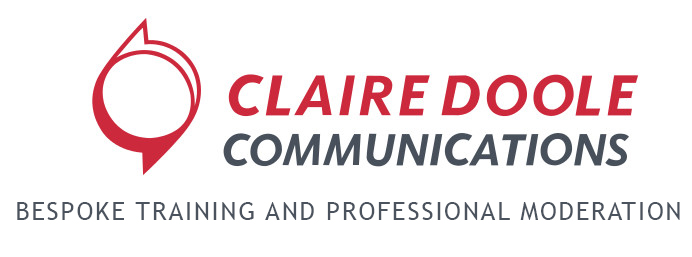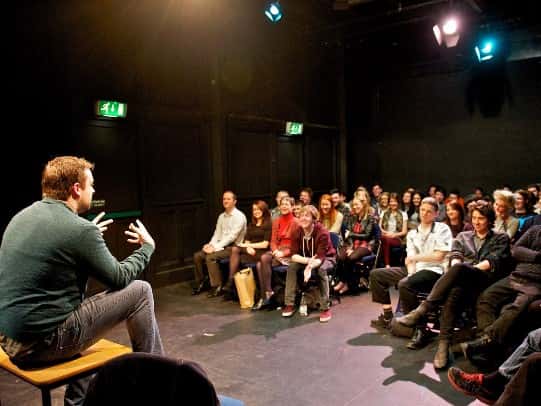
by Claire Doole | Oct 14, 2018 | Blog
Rapport is the foundation of influence and impact. An American psychiatrist and psychologist, Milton Erickson, once said, “With rapport, everything is possible. Without it, nothing is possible.”
So what is this magical ingredient in effective communications? It is about being on the same wavelength as someone else so that we feel connected. It often involves having shared values, beliefs or similar life experiences. I know, for example, that I usually instantly connect with someone who is or has been a journalist due to my time at the BBC.
But how do you build rapport with an audience made up of many different individuals? This is vital when you are speaking in public presenting, giving a keynote speech or sitting on a panel at a conference.
Many of the things that you do naturally one-on-one are applicable, such as finding common ground, asking questions and actively listening to what they are saying.
But when you want to build rapport with an audience, you need to use these skills more consciously.
Let me explain by sharing my list of how to do it, based on my experience as a moderator and public speaking coach.
Finding common ground
When you prepare your speech or remarks you need to think about your audience first and foremost. What are their needs, expectations and challenges? Far too often presenters think that communication is a one-way process but to have impact you need to ensure that your message has got across to the audience so that they are not only engaged but also feel, say or think differently as a result of your presentation.
Reading the room
I am often asked by people I coach/train how do I know that my message has landed. Well, the first thing is to read the room. Are people looking at you or reading their emails or looking out of the window? If they are looking at you, how are they looking – quizzically or in agreement? Do they have their hand on their chin, as this is often a sign that they are listening intently? What is their body language telling you? Are they slumped in their chair? Are they leaning back with a bored expression? If so it is up to you to reconnect again by changing your voice, body language or content.
Articulating what you see
This is a coaching technique that is very effective when speaking in public. If you see that your audience is either with you or against you, tell them what you are seeing. Check back with them if you are right that they are puzzled, sceptical or engaged. If you do this, it shows that you are in the moment and present and will show your audience that you care about them and their reaction.
Actively listen
Another coaching technique. We often listen at a superficial level – just waiting for our turn to speak. But you need to fully focus and show you are listening. You can do this with your body language – nodding your head, putting your hand on your chin, briefly moving towards the questioner during the Q and A session if standing or leaning forward if sitting. You can also do this by repeating back the same words or even using the same metaphors and analogies as the person who is talking. For example, “You say that you feel frustrated, that you are drowning with work, …..”
Pathos, pathos, pathos
As Socrates said if you want to really influence someone you have to have logos (logic), ethos (credibility) and pathos (stir emotion in the audience). You can read more about this in a previous blog.
Many of the people I coach and train shy away from stirring emotion in a professional context, but if you can add a dash of storytelling in your speech or remarks, you will immediately build a connection with the audience as since childhood we have been hot-wired to love stories.
All of this takes courage.
As you can see from this diagram about building rapport, if you move beyond the cliché and facts and start to share beliefs and opinions, you will build rapport. However disclosing more and increasing trust, does come with risks.
But if you want to have impact and influence, and it is done well, then I believe it is a risk worth taking.
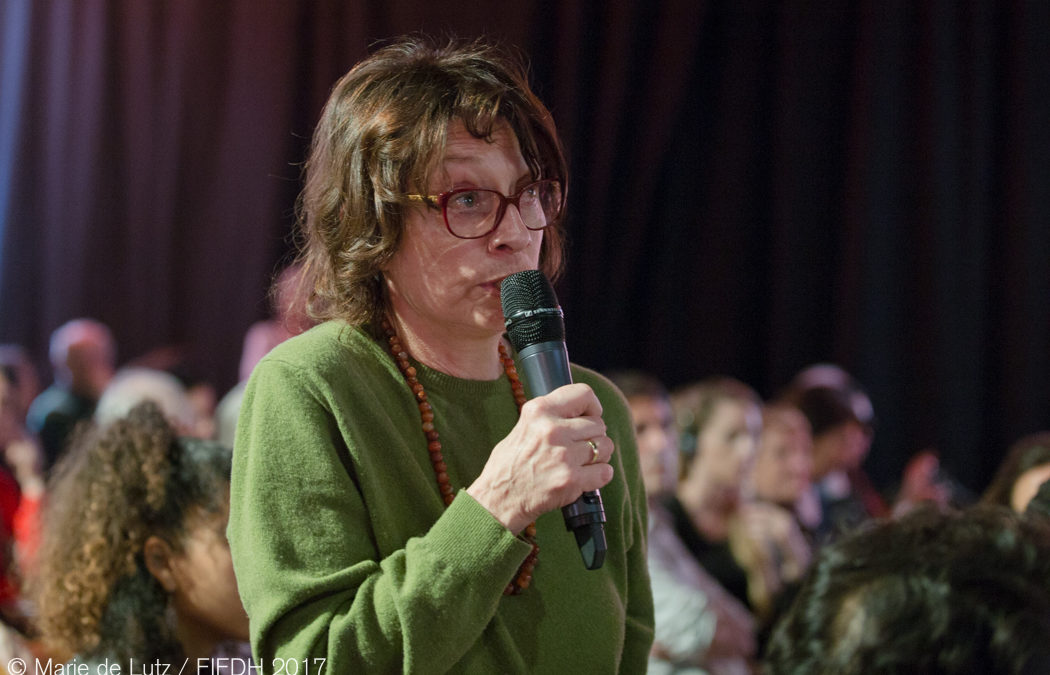
by Claire Doole | Sep 4, 2018 | Blog
I was at a conference recently where during the Q and A session, the moderator failed to stop a woman from sharing her life experience as a refugee with the audience. Interesting, as it was how she ended up in Oxford from Myanmar, it was not relevant to the subject of the panel.
As the audience became restless with many rolling their eyes, the moderator did try to interrupt and ask for her question. She said she had no question but thought the audience should know about what she went through!
This made me think of how important it is as a moderator or as a presenter that you handle effectively the Q and A session.
Below are some tips based on my experience as a moderator and presenter who trains in both disciplines.
The audience member, who doesn’t ask a question, but makes a comment.
- Make it clear before you take a question that you want a question not comments.
- Take a leaf out of the book of Christiane Amanpour, the doyenne of CNN, when she moderated a panel at the UN in Geneva.
It is a technique that I find usually works but sometimes as Christiane discovered, it fails to deter the persistent. If this happens to you, you must wait for the person to draw breathe and politely interrupt for the sake of the audience and the panel members, as Christiane does here.
However, you may find, as I did, that certain audience members believe they should have been on the panel and therefore want to share their experience. This is fine as long as the organisers let you know beforehand that someone wants to intervene with a comment.
Handling the audience member who rambles
This happened to me during one of the first panels I moderated. The culprit was sitting right in my line of view so I went to him first. He made no sense as he started to read long passages from a text. I looked at the panellists to see if they understood, but found they were just as nonplussed.
I asked him to get to the point, but he continued to ramble. As the audience began to stir in their seats, I politely told him that we would answer his question in the break.
- Don’t wait until the audience become impatient before asking the questioner to clarify. If they don’t, tell them the panellists will answer their question after the event.
- Ask the organisers beforehand if there is anyone in the audience who is likely to make comments, or speeches. In this case, the person in question was a serial offender and had previously been asked to leave by security when he kept on talking without getting to the point!
Handling the audience member whose English is not understandable
This is my weak point. I speak French and German and am well aware how difficult it is to ask a question in public in a foreign language. I can be too indulgent and try and help the person too much to make their point.
- Seek clarification once, paraphrasing and checking back with them that you have understood.
- If this fails, ask if anyone in the audience can translate the question for the panel.
- Ask the organisers beforehand to provide simultaneous translation if they think the audience will benefit.
Handling the hostile questioner
In my experience this is more of an issue for the presenter/panellist than the moderator. However, the technique is similar.
- Listen actively – try to understand what they are really saying/mean and feel.
- As the moderator, you should understand and acknowledge their concern. As the presenter/panellist, you could reformulate the question positively and answer with what you know or believe. You can also involve the audience and ask their view.
- Closure – check back as the presenter/panellist or in some cases as the moderator that you have answered their question or addressed their concern.
Often people are nervous about the Q and A session, but if you take control you will earn the respect of your audience, panel and the organisers, not least because you have kept the event on time and on track.
If you would like more tips on handling the Q and A session as a panel moderator or when giving a presentation, do attend one of my moderating or presenting trainings.
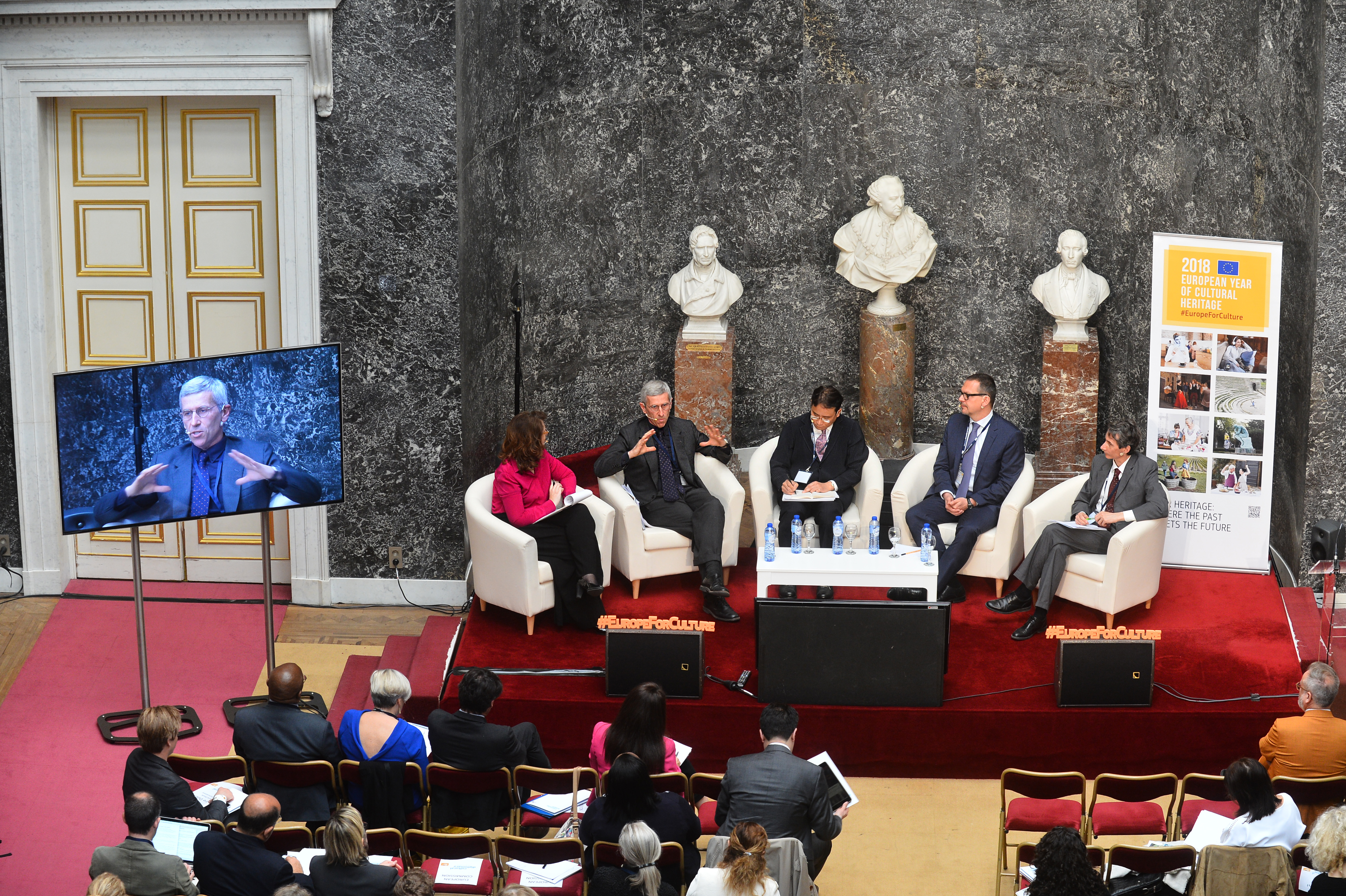
by Claire Doole | May 27, 2018 | Blog
After a busy month of moderating for the UN, European Commission and trade federations in Brussels and Geneva, plus running how to moderate workshops for public and private sector institutions, I wanted to share my top 6 tips for successful panel discussions.
The common theme is that while a professional moderator always adds some sparkle, it is difficult to wave a magic wand, if the event organisers have not thought editorially about the panellists and format.
Tip number 1
Select the right panellists for the topic. It sounds obvious, but too often panellists are chosen for political reasons rather than for what they bring to the discussion. Even the most seasoned moderators find it very hard to stimulate an engaging discussion with people who don’t have opposing views or different perspectives.
There is nothing worse than a panel where everybody says the same thing. In this case, as the moderator you have no option but to play devil’s advocate. I was once forced to do this during a discussion on refugees. Afterwards, a young student in the audience came up to me and accused me of not liking refugees. I told her that I used to be a spokesperson for the UN Refugee Agency but my role was not to like or dislike but to stimulate discussion.
Tip number 2
Involve the moderator in panel selection. Many moderators are former broadcast journalists, so they can advise on the range of opinions that are necessary for a stimulating discussion. They can also ensure that there is editorial coherence in the programme as the event unfolds. For me organising an event is like producing a radio/TV programme. It takes time, thought and strong editorial skills.
Tip number 3
Follow BBC best practice. As a producer, you never put anyone on air without checking that they were not only articulate but also had something new or interesting to say. You then wrote a brief for the presenter, who worked out the questions and flow of the discussion.
You were normally looking for those who held opposing views, for or against a subject, but on magazine programmes you often wanted a range of views. These could be demographically different (gender, age, ethnicity) geographically (local, national, regional, international) or involve different stakeholders (government, private sector, NGO, trade union, academic).
Tip number 4
Avoid the presentation style format. This is where each panellist has 10 to 15 minutes to present their perspective, ending with audience Question & Answer. This risks death by PowerPoint, and as people rarely time their presentations – a major mistake – they usually go over and leave little if no time for the audience to ask questions. As the moderator, it is much more difficult to stop someone mid-presentation, although I have done this in the interests of good time management and audience sanity!
If organisers/panellists insist then I suggest I ask them a series of prompt questions so that they can talk around their slides. It takes more work from the moderator and the panellists, but it is more dynamic as it is a conversation.
Tip number 5
Be wary of the opening remarks format. Here each panellist takes 5 minutes to introduce themselves and their perspectives on the topic before the moderator poses questions and the audience Question & Answer. Again, the panellists often talk over their allotted time, but even more problematic is that this can easily be too much information for the audience to remember.
This format works if it is agreed beforehand that the speakers are concise and their remarks pertinent to the subject. For example, if they set the scene for the discussion by introducing their project or programme. If they start to explain issues which are going to be addressed later in the panel discussion, this can become difficult for the moderator to follow up without repeating what has already been said.
Tip number 6
Opt for the Question and Answer Format. Here the moderator either opens with the same question for all panellists or rather like the conductor of an orchestra, brings in the panellists one by one at the right moment in the conversation. For this to work the organisers have to have selected the right panellist (see tip 1) otherwise the moderator spends a lot of time trying to join the editorial dots with a disparate group of people!
If you would like to learn how to moderate like a professional, then drop me a line for details of my in-house one-day workshops or one-on-one coaching sessions.
SUBSCRIBE TO CLAIRE'S BLOG
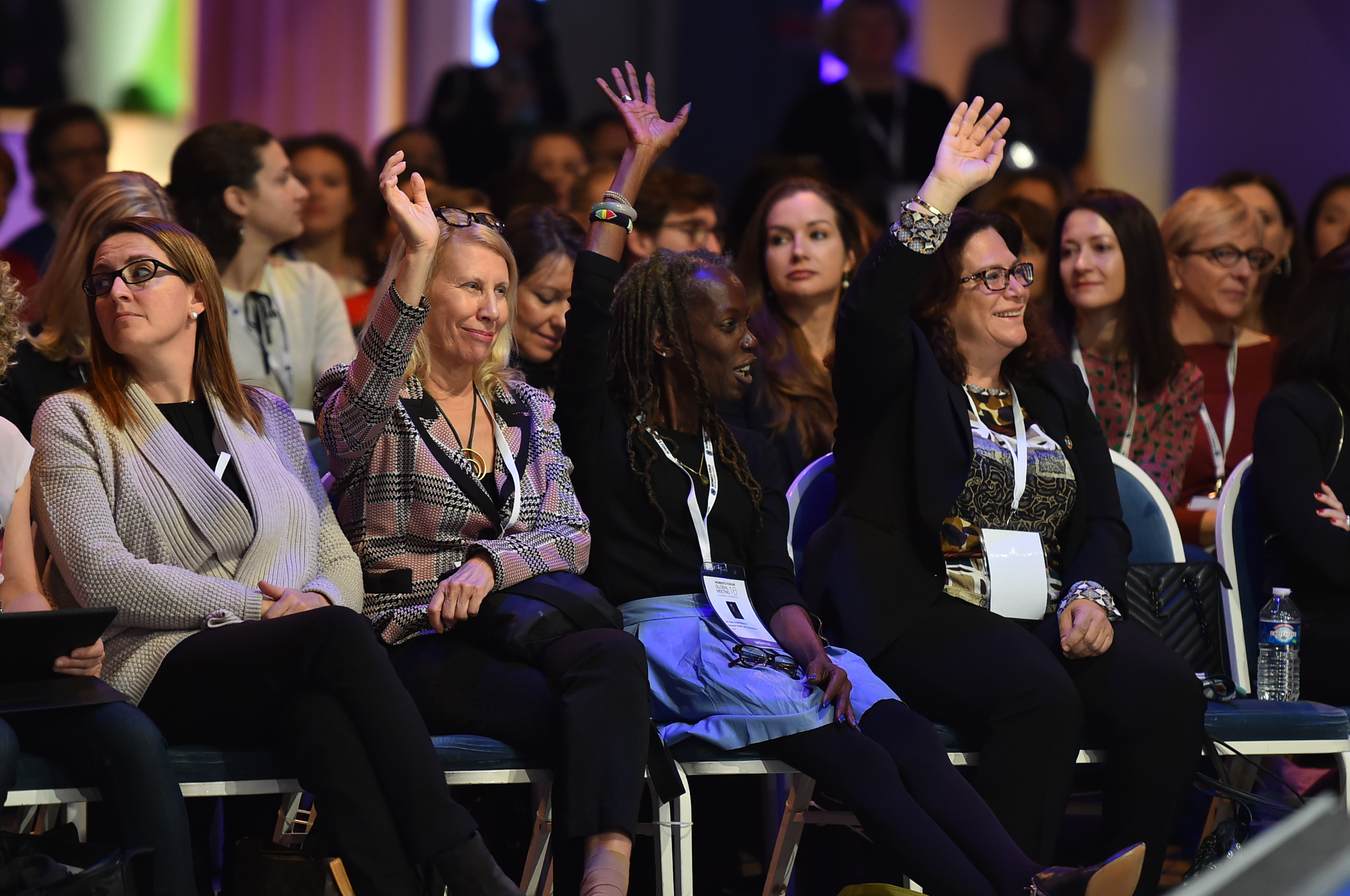
by Claire Doole | Dec 10, 2017 | Blog
The audience is king in communications. Whether giving a presentation, talking to the media, or writing a document, who matters most is the viewer, listener or reader. What do you want them to do, feel or say as a result of your communications?
How strange this is too often forgotten when organising a conference.
I am sure you have attended conferences where death by PowerPoint was a real possibility or panel discussions where the moderator runs out of time for the Q and A session with the audience.
Have a read of this article by Guardian journalist, Duncan Green entitled “Conference rage: How did awful panel discussions become the default format?”
He says, “a badly run conference is not only a lost opportunity, but a waste of time. How can we improve them?”
He gives a lot of good ideas, but doesn’t mention how technology can really make a difference, putting the audience back in the driving seat.
Interactive web applications – the moderator’s friend.
This year, I have moderated or acted as Master of Ceremonies at a number of events organised by companies, trade federations and international organisations. Many of them used web applications, which asked the audience to give their view on the subject under discussion or as a way to take questions or comments during the Q and A.
Two of the most popular apps are wisembly.com and slido.com. They promise amazing conversations, using a collaborative platform to maximise interaction at events and meetings.
So how do they work?
The audience downloads the app on their tablet or IPhone, put in the event code and then can ask questions during the Q and A session or take part in “real time” polls. The results appear on a screen in the room.
Many people feel nervous asking a question, especially if not in their native language. They prefer the more anonymous way of asking digitally. The only disadvantage is that the moderator has to understand the question or comment, especially difficult if it includes acronyms. It has to be made clear also who on the panel should respond and of course the moderator can’t check back for clarification with the questioner.
However, the part I really like is that the event organisers can ask the audience questions before the panel discussion. The responses appear on the screen within a minute. It is like getting the election results in real time.
Have a watch of this video from slido.com
As the Master of Ceremonies at the Future of Europe’s Finances Conference in Brussels, I used it firstly to find out who was in the room. We provided a list: European Commission officials, industry, academics, or other.
In retrospect, NGOs should have had their own category and not been relegated to “other”. The NGO’s were quick to tell us that on Twitter – the advantage of a two-way social media conversation!
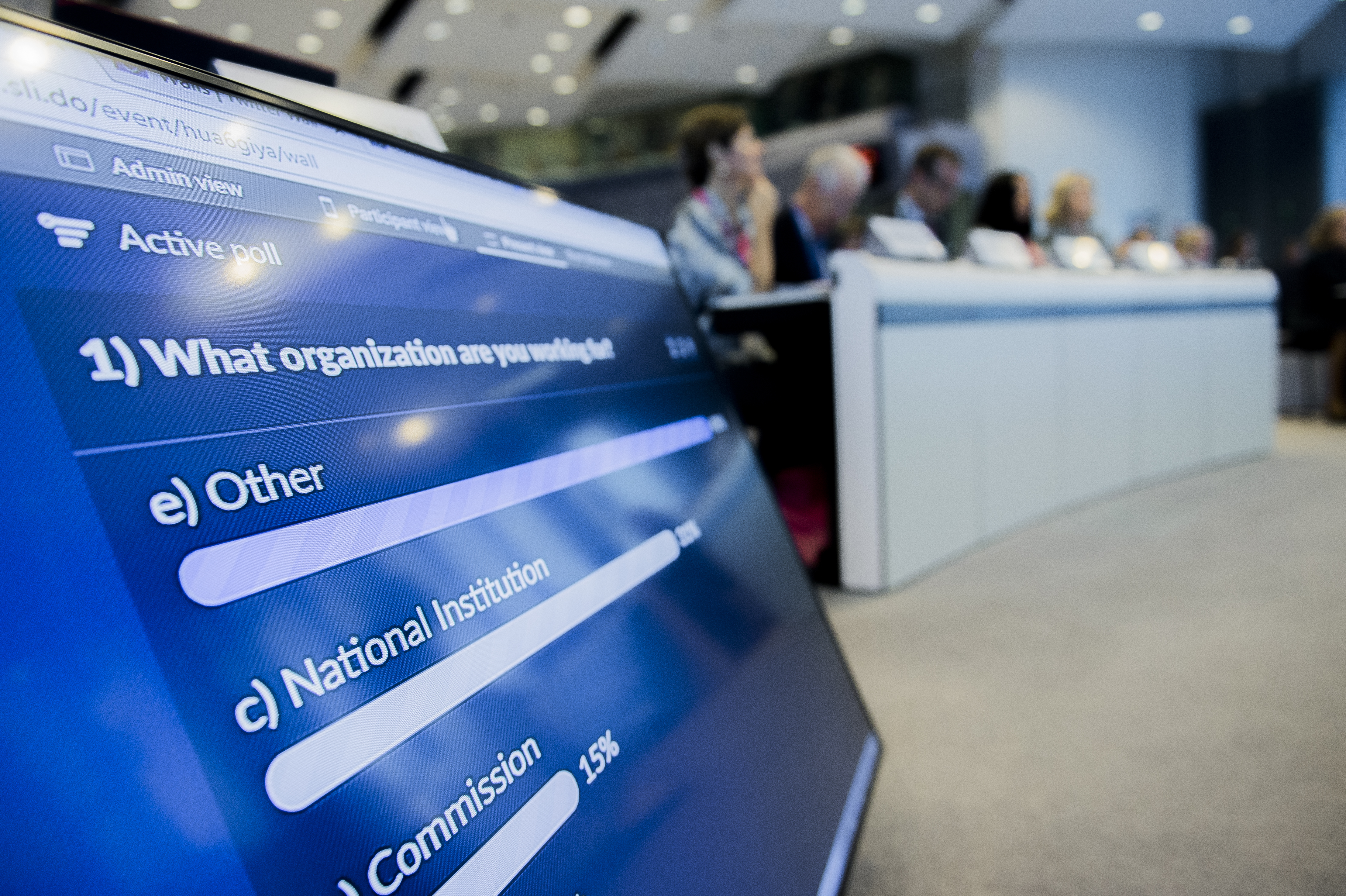
Brussels, Belgium – 25 September 2017
“The Future of Finances” conference.
Photo: European Commission / Ezequiel Scagnetti
We then went on to ask more specific questions.
The moderator can use the results of a survey in a number of ways either by using the answers to start the panel discussion or refer to them during the discussion. You can also use the survey questions as a transition technique between panels, particularly useful as people leave and come on to the platform.
If you are really brave, you can use the word wall. This is where you ask people to write the word that they most associate with the conference. You show the results at the end. Of course the moderator/MC has to go with the flow if some of the words are not those the organisers expected!
At every event where I have used these applications, the audience has responded with genuine enthusiasm. They create a buzz and make the audience feel that they are really part of the event, restored to their rightful position as event royalty.

by Claire Doole | Sep 24, 2017 | Blog
A straw poll of colleagues and clients confirmed my view that people often confuse the different roles.
I frequently receive confused requests. Not so long ago, I was asked to moderate when in fact after some discussion the client and I agreed they needed instead a Master of Ceremonies. Another client contacted me to moderate, but in fact what they required was a Master of Ceremonies and facilitator.
When organizing an event, how do you make sure you get the right person for the right job?
Some broad definitions to keep in mind:
- A moderator guides the discussion, often but not always in a panel format.
- A Master of Ceremonies is responsible for the “show* – the whole event as it unrolls on the day.
- A facilitator is responsible for a process – helping people make decisions and achieve results.
While there are differences in responsibilities, there is a common base of skills across the three roles: you need someone who is neutral, is a good listener, and is a clear and confident communicator.
The nuance is that the different roles require more of one skill over another. By understanding this difference, you can be sure that you have hired the right person for the right job. .
From my experience, here are the prerequisites.
The ideal Moderator:
- Knowledgeable – knows enough about the key issues to guide the conversation and ask the thoughtful questions. They are not subject experts, but they know how to research the arguments and draw out the main points.
- Probing – is confident about asking thought-provoking questions to ensure a stimulating and lively discussion.
- Engaged and engaging – is constantly thinking about the audience needs, making sure the conversation is meaningful for them and prepared to inject humour when need be.
- Outcome orientated – works with the organiser to ask the questions they want asked to get the results they want.
Top Tip: TV and radio journalists are naturally good at this as they are used to distilling complex information and asking questions in a linear and easily understandable way. Make sure though they realise they are working for you and no longer for their editors!
The ideal Master of Ceremonies:
- Personable – knows how to build rapport with the audience so that they are engaged throughout the event. If the audience doesn’t like the personality of the MC, the success of the event will be compromised.
- Energetic and enthusiastic – works the room so that the audience is engaged, entertained, and energized.
- Quick-witted – picks up quickly on verbal cues and link seamlessly from one session to another.
- Charismatic – has confidence, presence and impact.
Top Tip: You need to get the right personality for your audience. If you are organising a big event you may want an actor/celebrity/broadcast presenter. But be careful that it does not become all about them!
The ideal Facilitator:
- Well prepared – works out a process and structure for the event to achieve a specific result.
- Analytical – identifies clear goals and links group feedback to them.
- Empathetic – listens well and support others when they lose focus
- Perceptive – links the response of the participants to the process and knows when to lift energy levels.
Top Tip: You need to look for facilitators who have a background in training and leadership development.
If you are organising an event, then do work closely with your “ideal” moderator, MC and facilitator, bringing them in as early as possible in the process to advise on content and format. This will make sure that you can the outcome you want.
If you are interested in this blog, have a read of other blogs on moderating.
Taking the Stress out of Moderating
How to be the Perfect Panelist
Creating a Perfect Panel
Moderating with Macron

